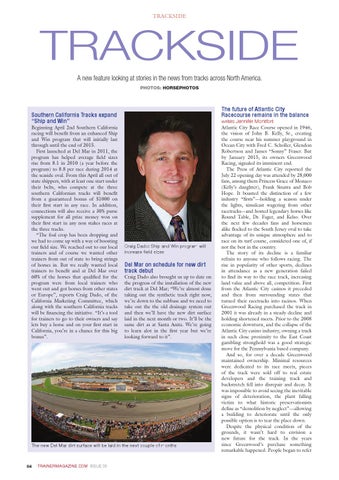TRACKSIDE
TRACKSIDE A new feature looking at stories in the news from tracks across North America. PHOTOS: HORSEPHOTOS
The future of Atlantic City Racecourse remains in the balance
Southern California Tracks expand “Ship and Win”
Beginning April 2nd Southern California racing will benefit from an enhanced Ship and Win program that will initially last through until the end of 2015. First launched at Del Mar in 2011, the program has helped average field sizes rise from 8.1 in 2010 (a year before the program) to 8.8 per race during 2014 at the seaside oval. From this April all out of state shippers, with at least one start under their belts, who compete at the three southern Californian tracks will benefit from a guaranteed bonus of $1000 on their first start in any race. In addition, connections will also receive a 30% purse supplement for all prize money won on their first start in any non stakes races at the three tracks. “The foal crop has been dropping and we had to come up with a way of boosting our field size. We reached out to our local trainers and of course we wanted other trainers from out of state to bring strings of horses in. But we really wanted local trainers to benefit and at Del Mar over 60% of the horses that qualified for the program were from local trainers who went out and got horses from other states or Europe”, reports Craig Dado, of the California Marketing Committee, which along with the southern California tracks will be financing the initiative. “It’s a tool for trainers to go to their owners and say lets buy a horse and on your first start in California, you’re in a chance for this big bonus”.
writes Jennifer Montfort
Craig Dado: Ship and Win program will increase field sizes
Del Mar on schedule for new dirt track debut
Craig Dado also brought us up to date on the progress of the installation of the new dirt track at Del Mar; “We’re almost done taking out the synthetic track right now, we’re down to the subbase and we need to take out the the old drainage system out and then we’ll have the new dirt surface laid in the next month or two. It’ll be the same dirt as at Santa Anita. We’re going to learn alot in the first year but we’re looking forward to it”.
The new Del Mar dirt surface will be laid in the next couple of months
84
TRAINERMAGAZINE.COM ISSUE 35
Atlantic City Race Course opened in 1946, the vision of John B. Kelly, Sr., creating the course near his summer playground in Ocean City with Fred C. Scholler, Glendon Robertson and James “Sonny” Fraser. But by January 2015, its owners Greenwood Racing, signaled its imminent end. The Press of Atlantic City reported the July 22 opening day was attended by 28,000 fans, among them Princess Grace of Monaco (Kelly’s daughter), Frank Sinatra and Bob Hope. It boasted the distinction of a few industry “firsts”—holding a season under the lights, simulcast wagering from other racetracks—and hosted legendary horses like Round Table, Dr. Fager, and Kelso. Over the next few decades fans and horsemen alike flocked to the South Jersey oval to take advantage of its unique atmosphere and to race on its turf course, considered one of, if not the best in the country. The story of its decline is a familiar refrain to anyone who follows racing. The rise in popularity of other sports, declines in attendance as a new generation failed to find its way to the race track, increasing land value and above all, competition. First from the Atlantic City casinos it preceded and then from surrounding states that turned their racetracks into racinos. When Greenwood Racing purchased the track in 2001 it was already in a steady decline and holding shortened meets. Prior to the 2008 economic downturn, and the collapse of the Atlantic City casino industry, owning a track in such close proximity to the East Coast gambling stronghold was a good strategic move for the Pennsylvania based company. And so, for over a decade Greenwood maintained ownership. Minimal resources were dedicated to its race meets, pieces of the track were sold off to real estate developers and the training track and backstretch fell into disrepair and decay. It was impossible to avoid seeing the inevitable signs of deterioration, the plant falling victim to what historic preservationists define as “demolition by neglect”—allowing a building to deteriorate until the only possible option is to tear the place down. Despite the physical condition of the grounds, it wasn’t hard to envision a new future for the track. In the years since Greenwood’s purchase something remarkable happened. People began to refer
